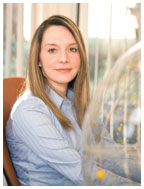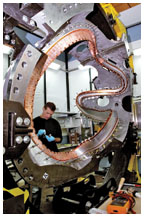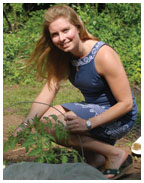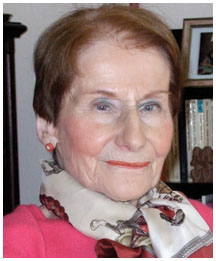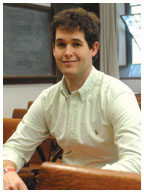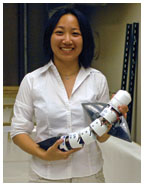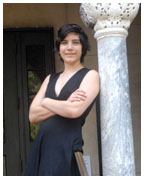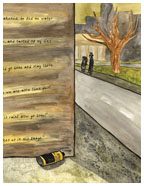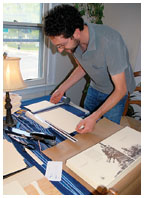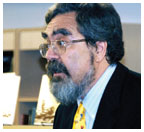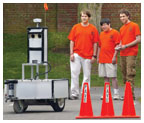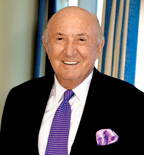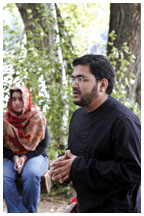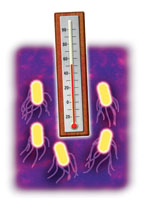July 16, 2008: Notebook
Princeton researchers catch a star in the act of exploding
Seven alumni join University's Board of Trustees
Major fusion project gets the ax
Thesis work ranges from ‘slow food' to a robotic eel
A publishing house that creates each book by hand
Grafton on digitization and the future of libraries
Winning debut for team's robot
$100 million gift from Andlinger '52
Top: a digital representation of the explosion of a supernova Below: researcher Alicia Soderberg says she "won the astronomers' lottery." (Photos: Office of Communications ) |
Princeton researchers catch a star in the act of exploding
On Jan. 9, 2008, Alicia Soderberg, a postdoctoral research associate in astrophysics at Princeton, was studying the X-ray emissions conveyed from space by NASA's Swift satellite when she recognized an extremely bright light on the screen of her computer, saturating the satellite's view "as if we had pointed a digital camera directly at the sun," she said. That light, Soderberg and colleague Edo Berger later confirmed, was a supernova — an explosion of a massive star.
Their finding, named Supernova 2008D, or SN 2008D for short, was described in a paper published in Nature May 22. In a May 21 teleconference, Soderberg described the experience as being in the right place, at the right time, with the right telescope. "I truly won the astronomers' lottery," she said.
Seeing a supernova is not unusual — the stars are brighter than 100 billion suns. But in the vastness of space, there generally is a delay of days or weeks between a supernova's explosion and its discovery by astronomers. By then, "most of the fireworks are already over," Soderberg said.
Soderberg saw the explosion live, or live on tape in a sense, downloading the data from the Swift satellite's observations while she was at an academic conference in Michigan. She had been using Swift to study another supernova, SN 2007uy, in the spiral galaxy NGC 2770, located 90 million light-years from Earth in the constellation Lynx. Seeing two supernovae in the same galaxy in a matter of weeks is extraordinarily unusual — a one-in-10,000 chance, she estimated. A typical galaxy produces one supernova every 100 years.
The Swift satellite, NASA principal investigator Neil Gehrels explained, was designed to detect and study gamma-ray bursts — brief, intense flashes of radiation — but it also is equipped to observe other "targets of opportunity" in the sky. When the Princeton pair spread the word about the unusual discovery, colleagues turned the lenses of other telescopes, including the Hubble Space Telescope, toward the new supernova, beginning a broad and intensive series of observations. Forty-two authors contributed to the Nature paper that described the birth of SN 2008D.
The use of an X-ray flash, rather than optical observation, to detect a supernova marks a "paradigm shift" and could lead to more discoveries, according to Robert Kirshner, a professor of astronomy at Harvard University and one of Soderberg's mentors. Soderberg and her co-authors estimate that future wide-field X-ray surveys could detect hundreds of exploding supernovae each year.
Soderberg, who earned her Ph.D. from Caltech and recently completed
the first of her five years as a Hubble Fellow and Carnegie-Princeton
Fellow, had the good fortune to be the first to observe SN 2008D, but
according to Kirshner, luck was only partly responsible for the discovery.
"If you're active and you're energetic, it helps a lot because you
manufacture your own luck, in a way," he said. "There's nobody
who's more focused and energetic than Alicia Soderberg."![]()
By B.T.
MORE ON THE WEB: See a digital video re-creation of the supernova explosion:
This animation (below) shows an artist's rendering of the shock wave
discovered by Princeton University's Alicia Soderberg and a team of scientists.
A supernova is born when the core of a massive star (the blue orb) runs
out of nuclear fuel and collapses under its own gravity to form an ultradense
object known as a neutron star. The shock wave erupts and ripples through
the star, emitting X-rays (seen here as bright white light). The remnants
of the explosion cool (the white light gets smaller), and then the visual
light from the supernova glows (seen as yellow clouds). The fading white
dot in the middle of the animation represents a newly born neutron star.
Courtesy NASA/Swift/Skyworks Digital/Dana Berry

Seven alumni join University's Board of Trustees
In June, seven alumni were named to the University's 40-member Board of Trustees. They are:
Katherine Bradley '86 of Washington, D.C., a longtime University volunteer and founder and president of CityBridge Foundation, a philanthropic organization that focuses on health and education.
Christopher Cole '81 of Hopewell, N.J., managing director at Goldman, Sachs & Co. He is a director of the Princeton University Investment Co. and serves on the advisory council for the Bendheim Center for Finance.
John Diekman '65 of Atherton, Calif., managing partner of 5AM Ventures, an early-stage life-science venture capital firm. He has been an Annual Giving volunteer, chairman of the University's Chemistry Advisory Council, a member of the University's Genomics Advisory Council, and the West Coast chairman of the Aspire fundraising campaign.
Michael Porter '69 of Brookline, Mass., the Bishop William Lawrence University Professor at Harvard Business School. He has done groundbreaking work on the competitiveness of companies, regions, and nations. He also helped to establish the Woodrow Wilson School's Policy Research Institute for the Region.
Kavita Ramdas *88 of Palo Alto, Calif., president and chief executive officer of the San Francisco-based Global Fund for Women, the largest foundation in the world dedicated exclusively to helping women and girls. She earned an M.P.A. from the Woodrow Wilson School and serves on the school's Council of Advisers on Gender Equity.
Gordon Wu '58 of Hong Kong, chairman and managing director of Hopewell Holdings Limited. Wu has donated more than $100 million to the University, and he has been a member of the engineering school's advisory council, the president of the Princeton Club of Hong Kong, and a Princeton-in-Asia governing board member.
Meaghan Petersack '08 of Mercerville, N.J., who served as class secretary for four years and worked with the Student Volunteers Council and the Pace Council for Civic Values. Petersack, elected as a young-alumni trustee, will join Teach for America this fall as an elementary school teacher in Washington, D.C.
Diekman was selected for a 10-year term as a charter trustee; the others
will serve four-year terms. ![]()

PPPL technician Doug Voorhees works on one of the stellerator's 18 coils. The project is being shut down. (Elle Starkman, courtesy Princeton Plasma Physics Lab) |
Major fusion project gets the ax
The Department of Energy is shutting down a major fusion-energy project at the Princeton Plasma Physics Lab after spending nearly $100 million on its design and construction.
Continuing to assemble the National Compact Stellerator Experiment — described in an April review as substantially over budget, four years behind schedule, and facing continued uncertainties — would put "the future of research at PPPL in unnecessary peril," said Raymond L. Orbach, under secretary for science at the U.S. Department of Energy.
Instead, Orbach said, the lab should focus on enhancing another fusion experiment that has been operating successfully since 1999 — the National Spherical Torus Experiment. The spherical torus is a device to study the physics principles of spherically shaped plasmas — hot ionized gases confined in a magnetic field in which nuclear fusion will occur.
"Proposed upgrades for the spherical torus experiment at PPPL can keep this facility at the forefront of fusion science research in the world well into the future," Orbach said in a May 22 statement. He stressed the DOE's "strong commitment to the future of PPPL." The lab dates back to 1951, when Professor Lyman Spitzer *38 initiated the study of fusion at Princeton.
Lab officials had hoped that the stellerator would come on line as PPPL's flagship experiment in time to replace the spherical torus, originally scheduled to shut down after 2010. But the stellerator, designed to test a possible configuration for a fusion-power reactor, fell victim to a tight federal research budget and to the complexities of its irregular shape — its 18 coils are described as among the most complicated electromagnets ever designed.
The stellerator project accounts for $14 million of the lab's $75 million annual budget; about 40 scientists, engineers, and technicians are directly involved with it. Princeton officials are hoping that for the next fiscal year, at least some of that money will be reallocated to the spherical torus — both in allowing the experiment to be run for more weeks during the year, and to begin the proposed upgrades.
A.J. Stewart Smith, dean for research, said enhancements to the spherical
torus could take three years to design and build at a cost "in the
tens of millions of dollars." But work to double the device's current
and magnetic field would increase its productivity four-fold, he said.
![]()
By W.R.O.
MORE ON THE WEB: Q&A with DOE's Raymond Fonck on the future of PPPL and fusion energy, click here.

Thesis work ranges from ‘slow food' to a robotic eel
Since the senior thesis became established as the capstone of a Princeton undergraduate education in the 1920s, thousands of independent-study projects have been completed on subjects as varied as the students themselves. Here is a sampling of thesis work by four members of the Class of 2008, in their own words:
Katy Andersen '08 (Photos: Zachary Ruchman '10)
|
Katy Andersen, French and Italian; certificate in environmental studies
Summary: Twice in the past 500 years, Italy has witnessed periods of profound scholarship and advancement in gastronomy that changed the human relationship with food. The first Western gastronomic treatise, published in 1468 and titled De Honesta Voluptate et Valetudine (Of Right Pleasure and Good Health), and its renaissance under the slow-food movement answer more than just the question, "Why do we eat what we eat?" Their principles formulate a cohesive and comprehensive theory of gastronomy. Ultimately, the stomach has a memory, but the mouth has a mind.
A campus farmers market is an exceptional venue for bringing delicious, sustainable food directly to students, faculty, staff, and members of the community in a fun, social setting. My farmers-market manual records the history of the Greening Princeton Farmers Market and details the steps followed to run this market or needed to start one's own campus market.
Advisers: Professor Pietro Frassica, French and Italian thesis; Xenia Morin, lecturer in the Princeton Writing Program and the Princeton Environmental Institute, for the manual
Reason for selecting the topics: The idea for my French/Italian thesis came out of readings selected by Professor Frassica in his course, "The Literature of Slow Food." While I refined this topic, our seminar took a trip to northern Italy where we met Carlo Petrini, the founder of the slow-food movement. Shaking his hand, I knew what I wanted to write about. The other paper, my farmers-market manual, represents three years of planning the Princeton campus farmers market. Princeton now has a thriving market, and we need to support it! I wrote the manual for future student directors, and expanded it to become a resource for students at other universities. It ended up being longer than my thesis. I hope to condense and publish it.
Biggest challenge: Eating! How can one write about food and not be constantly hungry? I wrote over half of both papers in a toasty corner of the Bent Spoon, whose delicious artisan ice cream made matters more difficult.
Plans after graduation: I am moving to northern Italy in October on a Fulbright scholarship to study artisan cheese production with the University of Gastronomic Sciences. When I return nine months later, I will attend Harvard Business School.
Dagmar Westberg
Matt Martin '08 |
Matt Martin, history
Summary: My work deals with two aspects of Hamburg, Germany, during the 1930s and the 1940s: Jewish life and the resistance movement. Hamburg's development as an independent city-state and the history of Jewish life in Hamburg were both fairly unusual. For a case study, I examine the experiences of Dagmar Westberg, heiress to the Beiersdorf Corp., whose father was classified as "Aryan" and mother as "Jewish."
Adviser: Professor Harold James
Reason for selecting the topic: I was involved with the German Summer Work Program, which helps Princeton students find summer internships in Germany. The summer after sophomore year, I had met David Fisher '69, the director of the program and president of the Princeton Alumni Association of Germany. David and other friends of Frau Westberg, the principal donor for the summer work program and a strong supporter of German-American friendship, saw a need to record her life experiences. After talking with Frau Westberg and several of her friends, we developed a plan for a paper on the subject, which would become my thesis. The point was to place Frau Westberg's experience in the more general experience of Germany in the 1930s and '40s.
Biggest challenge: The research presented multifaceted difficulties. Most of the books on my topic in Firestone were in German. While I am able to read and critically analyze the texts in that language, the reading and research process took much more time in a foreign language. The second difficulty was the bureaucratic process of archival research at the Hamburg State Archive, where I researched documents on the resistance movement as well as decrees that affected Jewish life in Hamburg.
Plans after graduation: I am interviewing for several jobs in New York, mostly in the areas of advertising and sales. I hope to begin in the late summer.
Yang Dai '08 |
Yang Dai, mechanical and aerospace engineering
Summary: My thesis was to design a robotic eel that is capable of swimming, diving, and maneuvering around obstacles autonomously. Innovations over previous designs included the use of a novel cable method for generating thrust, pectoral fins for diving and maintaining depth, and an onboard wireless camera and radio receiver for data transfer with an offboard PC.
Adviser: Professor Alexander Smits
Reason for selecting the topic: I've always had an interest in robotics and biology, and I knew Professor Smits previously had advised some really cool marine-inspired robot projects, so I met with him to discuss potential topics. Ultimately, my thesis was partially an extension of previous theses and partially development of ideas that my adviser's research group came up with when playing with a toy robotic shark.
Biggest challenge: My computer's operating system. Interfacing my various electronic components was a nightmare, and compatibility issues led to major delays in testing. Eventually, I just wiped the PC and installed another system.
Plans after graduation: I'm moving to Seattle to work for Boeing as a manufacturing engineer. I'm planning on going back to school in a few years to continue studying engineering.
Courtny Hopen '08
A page from Hopen's thesis. (Courtesy Courtny Hopen '08 |
Courtny Hopen
Summary: My thesis, "Uriel's Flood," is a graphic novel set in a futuristic New York City threatened by global warming. The plot focuses on the relationship between two young Orthodox Jews, Uriel and Sahra, as they deal with obstacles such as supernatural assassins, arranged marriages, environmental disasters, and mystical possession. The comic combines images, prose, and poetry and is inspired by works such as Neil Gaiman's The Books of Magic, Alan Moore's Promethea, and Marjane Satrapi's Persepolis.
Adviser: Professor James Richardson. I was also greatly aided by the staff of OIT's New Media Center, the deans and staff of Rockefeller College, and several classmates and friends.
Reason for selecting the topic: So that I could explore the relationship between words and images. Originally I wanted to do this through writing poetry alone, but I quickly realized that in addition to poetic images, I wanted to include literal images in my thesis. My father, Stuart Hopen '75, also gave me great advice, and is the one who indirectly inspired me to choose this project by sharing his love for comic books and literature with me throughout my life.
Biggest challenge: Producing the artwork (usually, there's at least an artist/writer team for works in color). Each page required a lot of time to produce: I had to draw the images, paint them, scan the painting, adjust it so the colors would turn out well, and then lay the page out and add text. Luckily for me, Rockefeller College opened a media center that was accessible to students 24 hours a day a couple of weeks before my thesis was due, complete with a nearby coffee machine.
Plans after graduation: I'm moving to New Orleans to
take a year off before going to graduate school for a degree in art therapy.
During my time in New Orleans, I hope to continue writing and painting,
as well as doing volunteer work. ![]()

Alexander Bick GS, founder of the independent publishing house Crumpled Press, prepares a book cover for binding. (Courtesy Nealin Parker) |
A publishing house that creates each book by hand
With the growth of digitized information on the Internet, and companies like Google bringing stacks of books virtually into people's homes and offices at the click of a mouse, some pundits are prophesying the end of "real" books.
But Alexander Bick, a graduate student in Princeton's history department, isn't convinced that we've seen the end of books that you can hold, mark up, and pass on to someone else. With two friends, Bick founded an independent publishing house, Crumpled Press, whose editors and volunteers, including Princeton graduate students, make each book and pamphlet by hand. In doing so, they are honoring the idea of books as aesthetic objects, not just transmitters of information.
In May, Crumpled Press was in the middle of binding its latest book, Codex in Crisis, by Princeton history professor Anthony Grafton, about digitization of information and the future of bricks-and-mortar libraries. (For more on Grafton and his book, see the Q&A below.)
On the living-room floor in Bick's Princeton apartment lay folded laser-printed copies of the pages of Grafton's book — flattened by gym weights. On a table was a box of book covers made from hand-molded French paper, alongside another box of prints — depicting the burning of the library in Alexandria — that would be taped carefully into the manuscripts. Each book would be folded, cut, and sewn by hand, using an awl to poke holes in the pages and needles and thread to bind the books.
The editors seek to create a community of readers, writers, and bookmakers by hosting book-binding "parties": Ten to 15 people gather in Bick's apartment for stretches lasting eight to 10 hours, including wine and cheese breaks. All the editing and labor is done voluntarily. "It's a labor of love," Bick says.
Founded in 2005, Crumpled Press aims to promote the "tactile" reading experience that can't be duplicated by reading information on a computer screen. "We are experimenting with how the reading experience can be transformed," Bick says.
With eight pamphlets and books published to date, the press publishes first-time authors and writings that might have been tossed aside — hence the name Crumpled Press — because they were not commercially viable for a mass-market publisher. This month Crumpled Press hopes to finish 'Tis of Thee: Reflections on the Fourth of July by Christopher Moses, a Princeton graduate student in history, based on a lecture he delivered last year to public school students in New Hampshire. The press prints between 100 and 1,000 copies per book, charging from $5 for its first pamphlet of poetry to $30 for Grafton's book.
Among those who helped produce Codex in Crisis were Laura Giles, curator
of prints and drawings at the Princeton University Art Museum; Steve Ferguson,
curator of rare books at Firestone Library; and Robert Milevski, preservation
librarian. "What we have tried to do," Bick says, "is bring
people together around books to discuss their content, to discuss books
as a particular medium, and to discover a kind of [scholarly] collaboration
... in the production and circulation of books." ![]()
By K.F.G.

Professor Anthony Grafton reads from his new book, "Codex in Crisis," at Labyrinth Books in May. (Courtesy Nealin Parker ) |
Grafton on digitization and the future of libraries
In his latest book, Codex in Crisis, published by Crumpled Press in May, history professor Anthony Grafton reflects on the staggering amount of information now available on the Web: millions of digitized books, scholarly journals, and archival material accessible to anyone with a laptop and Internet access. He looks at how digitization has changed the nature of reading, scholarship, and publishing, and examines the future of books and libraries. Grafton, who calls himself "a lover of old libraries," says there are some things a scholar can learn only by studying printed books in bricks-and-mortar libraries. Grafton spoke with PAW's Katherine Federici Greenwood.
How has the Web changed the nature of research for scholars and students?
Digitization has changed entirely not just the way we do research, but also the way we teach. ... For instance, instead of having to put copies on reserve and force people to sit in perhaps not-altogether-pleasant rooms, we now just put a link on our course's Blackboard site. Students can do their reading perfectly comfortably on screen or print things out. ... Most of my colleagues now will go especially to smaller archives, which may not have the facilities for photographs or digitization, with a digital camera and simply bring home their own photographed, archived images. So instead of trying to decipher a stack of contracts by a medieval notary in the archive for a whole summer, you can photograph them in a day and take the photographs home.
Why are actual books and archives still necessary?
There's no way that every copy of every book will ever be digitized. And some information you can't glean from a digitized copy of the original. For example, scholars who study the
history of books are interested not only in the content of a famous text like The Wealth of Nations ... but also in how people actually read it, who bought it, who owned it, what sorts of notes they took, whether the binding was leather or cloth. Scholars can read physical books for that kind of information, the way a scout reads a trail.
In Codex in Crisis I use the example of a scholar working in
a Portuguese archive who smelled 250-year-old letters, to see if they
smelled like vinegar. Because in the 18th century, when cholera struck
in the city, they would sprinkle letters going out with vinegar to disinfect
them. So real documents, material documents, real books give you huge
amounts of information which are either in practical terms difficult to
digitize, or are in some cases impossible to digitize. ![]()

From left, Andrew Saxe '08, Derrick Yu '10, and Gordon Franken '08 set up Kratos for a practice run in Princeton. (Frank Wojciechowski) |
Winning debut for team's robot
The Princeton Autonomous Vehicle Engineering team does not mind being an underdog. Since 2004, the group of undergraduates, better known by the acronym PAVE, has built self-driving trucks for high-tech competitions sponsored by the Defense Advanced Research Projects Agency (DARPA), competing against teams of professors, postdocs, and graduate students and performing well, despite having a limited budget and relatively little experience.
But this spring, nine students from PAVE decided to try what team member Gordon Franken '08 called "a more approachable challenge." They entered the Intelligent Ground Vehicle Competition, a robotics contest for undergraduates held in Rochester, Mich., May 30–June 2. Relying on skills developed in the DARPA projects, PAVE made an impressive debut, winning the event's design competition, placing third among 47 teams in the overall standings, and earning the Rookie of the Year award.
Team leader Jonathan Mayer '09, a Woodrow Wilson School major, said that the project required a mix of creative computer programming and dirt-under-the-nails engineering. The team's robot, Kratos, named for the Greek god of power, featured a stereo camera, digital compass, and GPS device mounted on a tower at the back of a sturdy, hull-like aluminum frame that contained the robot's motor and three wheels (two in the back, one in the front). Two internal computers, which the team built from scratch, ran code that enabled the robot to find specific GPS locations and chart an optimal course around any obstacles spotted by the camera without any human guidance. While Kratos was not flawless on the obstacle course, the robot's errors were grazes and sideswipes, Mayer said, not head-on collisions.
Eight of the nine team members will return to Princeton in the fall
to work on PAVE's next project. Mayer is intrigued by a contest for autonomous
submarines, while Chris Baldassano '09, who is working in a robotics lab
at the University of Pennsylvania this summer, likes the idea of creating
a flying robot. Franken said a few students are tinkering with PAVE's
fall 2007 project, Prospect 12, a self-driving SUV that competed in the
DARPA Urban Challenge. Their goal for the summer is to make Prospect 12
capable of passing the New Jersey driver's exam — without a driver.
![]()
By B.T.

Gerhard R. Andlinger (Office of Communications) |
$100 million gift from Andlinger '52
The University announced a $100 million gift July 1 from GERHARD R. ANDLINGER '52 to support energy and environmental research.
The gift will create the Gerhard R. Andlinger Center for Energy and the Environment within the School of Engineering and Applied Science and will support construction of a 110,000-square-foot building, to be called Andlinger Laboratory, between the E-Quad and Bowen Hall. The center will include several new faculty positions; major research areas will include sustainable energy sources, techniques to improve carbon management, and energy efficiency.
"The work of the center will help create a better world for our children and grandchildren, which I see as a personal as well as institutional responsibility," Andlinger said. President Tilghman said the gift would position Princeton "to bring its very significant strengths in science, engineering, and public policy to bear on the challenge of developing technologies that will provide future generations with a healthy environment and sustainable sources of energy."
Andlinger, a native of Austria, is chairman of the private investment firm Andlinger & Co., based in Tarrytown, N.Y. His $25 million gift to Princeton in 2000 created the Andlinger Center for the Humanities.
(News of the Andlinger gift came as this issue of PAW was going to press;
more details will appear in the Sept. 24 issue.) ![]()

A federal CIVIL-RIGHTS INVESTIGATION of Princeton's admission process has broadened from reviewing the complaint of a single student claiming anti-Asian bias to a wider look at the admission of Asian students in the Class of 2010. The case began in 2006 when Jian Li, a Chinese-American student with a perfect 2400 SAT score, was placed on the waiting list at Princeton before being rejected for admission. Li said he had been discriminated against because he is Asian. He enrolled at Yale, and is now at Harvard. The Department of Education's Office for Civil Rights decided in January to open a broader compliance review to determine if the University "discriminates against Asians, on the basis of race or national origin, in its admissions process." University spokeswoman Cass Cliatt '96 said Princeton does not discriminate on the basis of race, color, or national origin. She said the University has continued to provide information to investigators, and is confident that the federal review "will affirm that our admission policy is in full compliance with Title VI" of the Civil Rights Act of 1964.
(Courtesy Sohaib Sultan) |
Sohaib Sultan, the Muslim chaplain at Wesleyan University and Trinity College and the author of The Koran for Dummies, will begin work next month as the University's first coordinator for Muslim life. Sultan said his initial priorities will be to develop the social and religious activities of Muslims on campus, enhance interfaith dialogue, and organize lectures and conversation "to critically examine Islam's role in our lives and in the world." The three-year position in the Office of Religious Life recasts what had been the part-time position of Muslim chaplain. Wasim Shiliwala '09, president of the Muslim Students Association, said he expects Sultan to be "a great resource." The group has between 60 and 100 members, but the number of Muslim students probably is larger, Shiliwala said.
The PRINCETON UNIVERSITY PREPARATORY PROGRAM, an academic and cultural enrichment program for high-achieving, low-income high school students from Trenton, Princeton, and other local districts, honored the 23 college-bound seniors in its fifth graduating class June 4. This year's ceremony also saluted the program's first college graduates, who joined PUPP in 2001 and finished their undergraduate studies this spring. Sixteen of the 21 original PUPP graduates completed their degrees in four years, including two Princeton alumni, Karl Micka-Foos '08 and Jamie Sparano '08. Jesus Lopez, a PUPP alumnus and 2008 Syracuse University graduate, will begin working toward a master's degree at the Woodrow Wilson School this fall.
A New York appeals court ruled last month that the University is entitled
to $9.6 MILLION in insurance payments toward the cost
of its defense in the so-called donor-intent lawsuit filed by members
of the family of the late Charles Robertson '26 and his wife, Marie. The
National Union Fire Insurance Co. had sought to limit its payment to $5
million. The Robertson family and the University have spent an estimated
$50 million in legal fees since the suit was filed in July 2002. ![]()

(Steven Veach ) |
Read and react
Bacteria can anticipate and prepare for changes in their surroundings
by recognizing environmental cues, such as a change in temperature, according
to Princeton research published in Science June 6. The authors, Saeed
Tavazoie, an associate professor of molecular biology, graduate student
Ilias Tagkopoulos, and postdoctoral researcher Yir-Chung Liu, set out
to explore whether intracellular networks had the capacity for the sort
of predictive behavior observed in organisms with more complex nervous
systems. In one study of E. coli, they found that a sharp rise in temperature,
like the one that the bacteria would experience when entering a vertebrate's
mouth, caused E. coli to switch off genes for aerobic respiration and
prepare to breathe without oxygen — a necessity when living in the
animal's gut. The finding, Tavazoie said in a news release, is the first
of its kind. ![]()

GILBERT HUNT *48, a longtime professor of mathematics
and an authority in probability theory and analysis, died May 30 in Princeton.
He was 92. A member of the faculty from 1959 to 1962 and from 1965 until
he retired in 1986, Hunt was widely known for developing tools to study
Markov processes. The "Hunt process," a key mathematical model
used in probability theory, is named for him. Hunt also was a top-ranked
tennis player as a young man. ![]()




